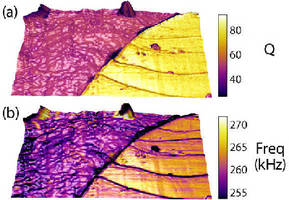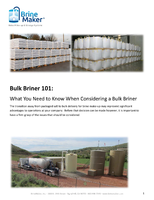Atomic Force Microscopes offer Contact Resonance mode.
Press Release Summary:

Available exclusively for Cypher™ and MFP-3D™ Atomic Force Microscopes, Contact Resonance Viscoelastic Mapping Mode enables high-resolution, quantitative imaging of both elastic storage modulus and viscoelastic loss modulus. Technique is particularly well-suited for characterizing moderate to high modulus materials in range of 1–200 GPa, such as composites, thin films, biomaterials, polymer blends, and even ceramics and metals.
Original Press Release:
Asylum Research Introduces Contact Resonance Viscoelastic Mapping Mode
Quantitative Nanomechanical Imaging of Both Elastic and Loss Moduli
(Santa Barbara, CA) Asylum Research, an Oxford Instruments company, announces Contact Resonance Viscoelastic Mapping Mode, an option available exclusively for Asylum’s Cypher™ and MFP-3D™ Atomic Force Microscopes (AFMs). Contact Resonance (CR) enables high resolution, quantitative imaging of both elastic storage modulus and viscoelastic loss modulus. The technique is particularly well suited for characterizing moderate to high modulus materials in the range of about 1GPa to 200GPA for materials such as composites, thin films, biomaterials, polymer blends, and even ceramics and metals. Exclusive Asylum hardware and software developments have made contact resonance imaging significantly faster, more quantitative, simpler to use, and applicable to a wider range of materials.
“Contact resonance techniques were first developed in the 90s, though until now, only as lab-built implementations. Asylum Research recognized the potential of this technology and focused our resources to provide this capability to our customers,” said Ben Ohler, AFM Business Manager at Asylum Research. “With help from industry-leading collaborators,we dramatically improved its speed, ease of use, and quantitative capabilities. The result of that work is Contact Resonance Viscoelastic Mapping Mode, the very first commercial offering of this technology.”
“An important feature of contact resonance imaging is that it characterizes the full viscoelastic response of materials,“noted Roger Proksch, President and co-founder of Asylum Research. “Some other nanomechanical imaging techniques only measure the elastic modulus of materials and have no capability to measure the loss modulus. However, both the elasticanddissipative response is critical to the performance of many modern materials. Contact Resonance Viscoelastic Mapping Mode provides a more complete picture which should enable more accurate and more useful insights into how nanomechanical properties influence real-world applications of these materials.”
A number of exclusive Asylum Research technologies enable the superior performance of Contact Resonance Viscoelastic Mapping Mode. Highly damped cantilever and sample actuators were developed for both the MFP-3D and Cypher AFMs to provide exceptionally clean, wideband excitation that makes operation far more robust and accurate. Dual AC™ Resonance Tracking (DART) and Band Excitation electronics make it possible to rapidly measure both the contact resonance frequency and quality factor, providing measures of both the elastic and viscous responses at higher speeds. Finally, exclusive software enables users to select the most appropriate analysis models and easily guides them through the steps required to calibrate the technique. The contact resonance packages are available for both new MFP-3D and Cypher S AFM systems and as upgrades to existing systems.
Contact Resonance Viscoelastic Mapping Mode is just one tool in the Asylum Research NanomechPro™ Toolkit, which includes many techniques for characterizing material properties at the nanoscale. Asylum believes that there’s not just one, best, “one-size-fits-all” approach to nanomechanics. Comparing the results from multiple techniques adds considerable confidence to the measurements and can provide new additional information.
For more information, visit our website at www.AsylumResearch.com/ContactResonance or email us at sales@asylumresearch.com for a quotation.
About Asylum Research, an Oxford Instruments company
Asylum Research is the technology leader in atomic force microscopy for both materials and bioscience applications, dedicated to innovative instrumentation for nanoscience and nanotechnology. Founded in 1999, Asylum Research has over300 years combined AFM/SPM experience among our staff. Asylum Research AFMs are used for a variety of nanoscience applications in material science, physics, polymers, chemistry, biomaterials, and bioscience, including single molecule mechanical experiments on DNA, protein unfolding and polymer elasticity, as well as force measurements for biomaterials, chemical sensing, polymers, colloidal forces, adhesion, and more.
Asylum’s MFP-3D™ family of AFMs sets the standard for AFM technology, with unprecedented precision and flexibility. Four configurations now comprise the MFP-3D family. The MFP-3D Origin, the most affordable member, offers performance and full upgrade potential. The full MFP-3D provides performance with the maximum versatility of a wide range of modes and accessories. The MFP-3D-BIO™ is the only full capability AFM integrated with commercial inverted optical microscopes for advanced bioscience research. In addition, our MFP NanoIndenter™ offers the only true instrumented indenting for quantitative measurements.
The Cypher™ AFM is the highest resolution fast scanning AFM, now with environmental control. Cypher provides low-drift closed loop atomic resolution for the most accurate images and measurements possible today, point defect atomic resolution, >20X faster AC imaging with small cantilevers, Spot-On™ automated laser and photodetector alignment for easy setup, integrated thermal, acoustic and vibration control, and broad support for all major AFM/SPM scanning modes and capabilities.
Asylum Research offers the best warranties in the industry, ranging from two to five years, along with unmatched customer support. Asylum has global sales and service offices in Germany, UK, Japan, Shanghai and Taiwan.
About Oxford Instruments plc
Oxford Instruments designs, supplies and supports high-technology tools and systems with a focus on research and industrial applications. It provides solutions needed to advance fundamental physics research and its transfer into commercial nanotechnology applications. Innovation has been the driving force behind Oxford Instruments' growth and success for over 50 years, and its strategy is to effect the successful commercialization of these ideas by bringing them to market in a timely and customer-focused fashion.
The first technology business to be spun out from Oxford University over fifty years ago, Oxford Instruments is now a global company with over 2000 staff worldwide and is listed on the FTSE250 index of the London Stock Exchange (OXIG). Its objective is to be the leading provider of new generation tools and systems for the research and industrial sectors.
This involves the combination of core technologies in areas such as low temperature, high magnetic field and ultra high vacuum environments, Nuclear Magnetic Resonance, X-ray, electron and optical based metrology, and advanced growth, deposition and etching.
Oxford Instruments aims to pursue responsible development and deeper understanding of our world through science and technology. Its products, expertise, and ideas address global issues such as energy, environment, security and health.
For further information please contact:
Terry Mehr, Dir. of Marketing, Asylum Research
805-696-6466
terry.mehr@oxinst.com




